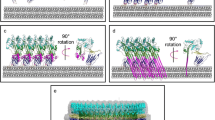Abstract.
Pore-forming toxins are widely distributed proteins which form lesions in biological membranes. In this review, bacterial pore-forming toxins are treated as a paradigm and discussed in terms of the structural principles on which they work. Then, a large family of bacterial toxins, the cholesterol-binding toxins, are analyzed in depth to provide an overview of the processes involved in pore formation. The ways in which the cholesterol-binding toxins (cholesterol-dependent cytolysins) interact with membranes and form pores, the structure of the monomeric soluble and oligomeric pore-forming states, and the effects of the toxin on membrane structure are discussed. By surveying the range of work which has been done on cholesterol-binding toxins, a working model is elaborated which reconciles two current, apparently diametrically opposed, models for their mechanism.
Similar content being viewed by others
Explore related subjects
Discover the latest articles and news from researchers in related subjects, suggested using machine learning.Author information
Authors and Affiliations
Corresponding author
Additional information
Received 7 September 2001; received after revision 12 November 2001; accepted 5 December 2001
Rights and permissions
About this article
Cite this article
Gilbert, R. Pore-forming toxins. CMLS, Cell. Mol. Life Sci. 59, 832–844 (2002). https://doi.org/10.1007/s00018-002-8471-1
Published:
Issue Date:
DOI: https://doi.org/10.1007/s00018-002-8471-1




